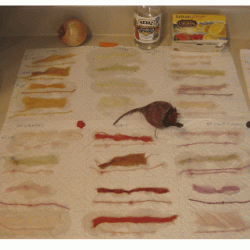Source Institutions
Source Institutions
Add to list Go to activity
Activity link broken? See if it's at the internet archive

In this activity, learners stain fabrics--on purpose! Learners explore the art of natural dyeing by using dyes and substrates that are both derived from plant or animal sources as well as mordant solutions. Learners compare the color and effectiveness of different mordant/dye combinations on the different substrates.
- Under 5 minutes
- 1 to 2 hours
- Over $20 per group of students
- Ages 11 - 18
- Activity, Experiment/Lab Activity
- English
Quick Guide
Materials List (per group of students)
- natural dyes: onion skins, carrot tops, blueberries, raspberries, hibiscus tea, beets, indigo, madder, or anything else you want to try
- copper sulfate, tin(II) chloride, alum (available in grocery stores), or any other polyvalent metal compound
- cream of tartar
- substrate: un-dyed wool yarn, cotton string or fabric, or other natural material
- water
- hotplate
- heat-proof containers
Subjects
-
Life Sciences
-
Diversity of Life
- Plants
-
Diversity of Life
-
Mathematics
- Measurement
-
Physical Sciences
-
Chemistry
- Chemical Bonding
- Solutions
- Vibration and Waves
-
Light and Optics
- Sunlight and Color
-
Structure and Properties of Matter
- Atomic Structure
- Elements and Periodic Table
-
Chemistry
-
The Nature of Science
-
The Scientific Process
- Conducting Investigations
-
The Scientific Process
Informal Categories
- Arts and Crafts
- Food and Cooking
- Gardening
Audience
To use this activity, learners need to:
- see
- see color
- read
- touch
Learning styles supported:
- Links STEM to other topics of interest such as arts and humanities
- Involves hands-on or lab activities
Other
This resource is part of:
Access Rights:
- Free access
By:
- Yu, Julie
Rights:
- All rights reserved, Exploratorium, 2010
Funding Sources:
- National Science Foundation, 0610238
- National Science Foundation, 0925383
